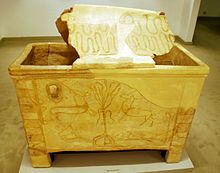Minoan chest sarcophagus in Hanover
A Minoan chest sarcophagus , also Larnax called, is one of the showpieces of the antiquities collection of the Museum August Kestner in Hannover .
Larnakes are sarcophagi made of clay, modeled on wood and a traditional part of the Minoan burial system. Apart from the only fragmentary cover, the Hanoverian Larnax is largely completely preserved. Defects, especially on one end, have been modernized. The remains of the lid were also put together and partially supplemented, but not completely restored. The lid was decorated with two wavy ribbons on top of each other. The lid has the shape of a pointed roof, the support surface has been flattened so that the lid rests securely on the sarcophagus. The sarcophagus itself is also painted on all four sides. On the main page a tree is shown in the center, to the left and right of it a wild goat and underneath it hunting dogs chasing the goats hit by spears. One side of the head shows two wild goats fighting with each other, the other, like the back, shows floral motifs. The interior of the sarcophagus is less carefully worked out than the exterior. Handles are attached to the ends of the long sides, but they are only preserved on both sides at one of the ends. The legs are carved out in a columnar protruding shape at all four corners, they run through from the upper edge to the floor. With the exception of one column on the back, which was decorated with flowers, all of these columns are alternately painted in thick strips or left with a clay background.
The Larnax belongs to the time after the destruction of the palace of Knossos . On the one hand it still bears traits of Minoan art, on the other hand Mycenaean influences are also palpable. While the Larnax shows the still existing Minoan influence, the painting is already very Mycenaean, although the motifs refer to Minoan beliefs. The tree is probably related to the Minoan tree cult, as it probably represents the sacred tree, the wild goats are probably related to the cult of a mountain goddess.
The Larnax is made in the 14th century BC. BC, which corresponds to a dating to the Late Minoan III A period. The sarcophagus probably came from the island of Crete . It came to the Museum August Kestner's collection of antiquities in 1989 (Inv.-Nr. 1989.30).
literature
- Hans-Georg Dettmer: "... awaken the sense of the beautiful ...". Guide through the Kestner Museum Hannover. Kestner Museum Hannover, Hannover 1998, ISBN 3-924029-28-8 , pp. 76-77.



